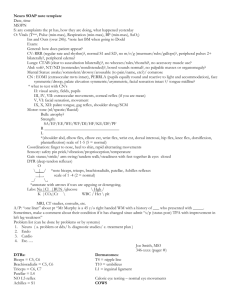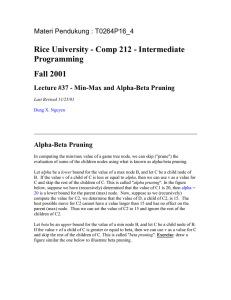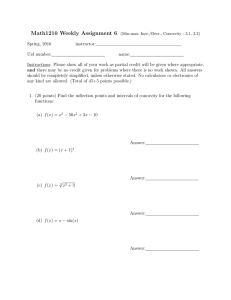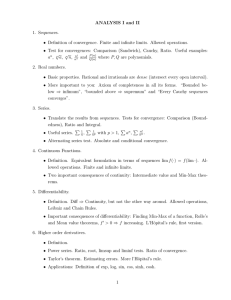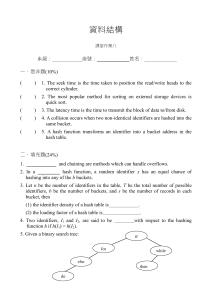the duality theorem for min-max functions
advertisement
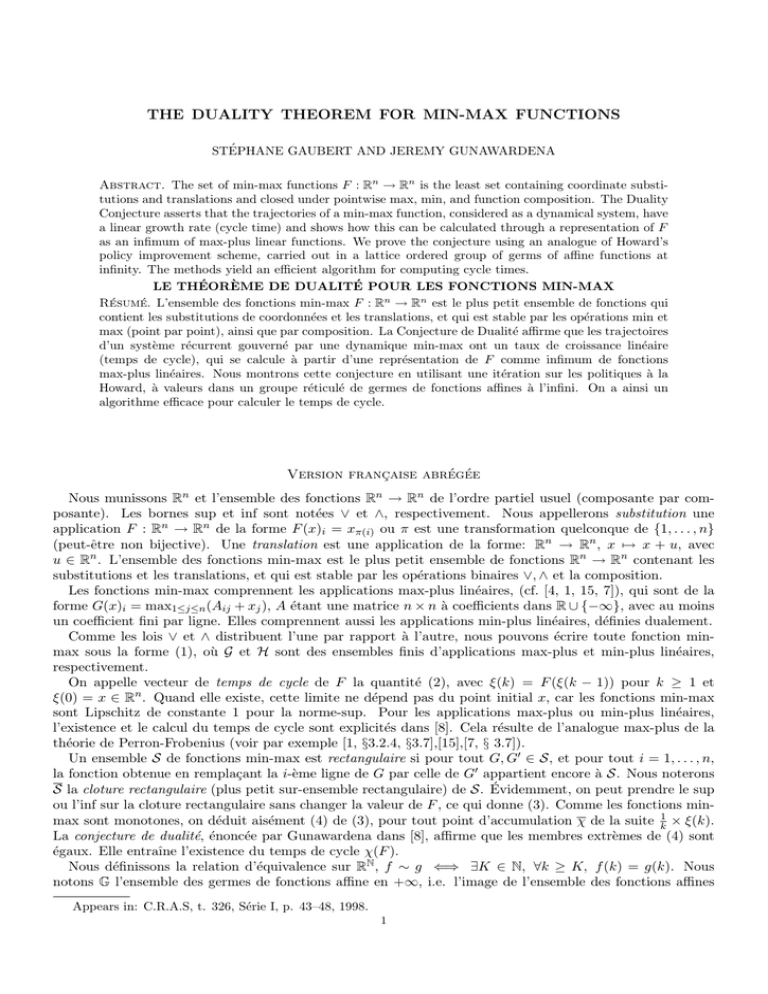
THE DUALITY THEOREM FOR MIN-MAX FUNCTIONS
STÉPHANE GAUBERT AND JEREMY GUNAWARDENA
Abstract. The set of min-max functions F : Rn → Rn is the least set containing coordinate substitutions and translations and closed under pointwise max, min, and function composition. The Duality
Conjecture asserts that the trajectories of a min-max function, considered as a dynamical system, have
a linear growth rate (cycle time) and shows how this can be calculated through a representation of F
as an infimum of max-plus linear functions. We prove the conjecture using an analogue of Howard’s
policy improvement scheme, carried out in a lattice ordered group of germs of affine functions at
infinity. The methods yield an efficient algorithm for computing cycle times.
LE THÉORÈME DE DUALITÉ POUR LES FONCTIONS MIN-MAX
Résumé. L’ensemble des fonctions min-max F : Rn → Rn est le plus petit ensemble de fonctions qui
contient les substitutions de coordonnées et les translations, et qui est stable par les opérations min et
max (point par point), ainsi que par composition. La Conjecture de Dualité affirme que les trajectoires
d’un système récurrent gouverné par une dynamique min-max ont un taux de croissance linéaire
(temps de cycle), qui se calcule à partir d’une représentation de F comme infimum de fonctions
max-plus linéaires. Nous montrons cette conjecture en utilisant une itération sur les politiques à la
Howard, à valeurs dans un groupe réticulé de germes de fonctions affines à l’infini. On a ainsi un
algorithme efficace pour calculer le temps de cycle.
Version française abrégée
Nous munissons Rn et l’ensemble des fonctions Rn → Rn de l’ordre partiel usuel (composante par composante). Les bornes sup et inf sont notées ∨ et ∧, respectivement. Nous appellerons substitution une
application F : Rn → Rn de la forme F (x)i = xπ(i) ou π est une transformation quelconque de {1, . . . , n}
(peut-être non bijective). Une translation est une application de la forme: Rn → Rn , x 7→ x + u, avec
u ∈ Rn . L’ensemble des fonctions min-max est le plus petit ensemble de fonctions Rn → Rn contenant les
substitutions et les translations, et qui est stable par les opérations binaires ∨, ∧ et la composition.
Les fonctions min-max comprennent les applications max-plus linéaires, (cf. [4, 1, 15, 7]), qui sont de la
forme G(x)i = max1≤j≤n (Aij + xj ), A étant une matrice n × n à coefficients dans R ∪ {−∞}, avec au moins
un coefficient fini par ligne. Elles comprennent aussi les applications min-plus linéaires, définies dualement.
Comme les lois ∨ et ∧ distribuent l’une par rapport à l’autre, nous pouvons écrire toute fonction minmax sous la forme (1), où G et H sont des ensembles finis d’applications max-plus et min-plus linéaires,
respectivement.
On appelle vecteur de temps de cycle de F la quantité (2), avec ξ(k) = F (ξ(k − 1)) pour k ≥ 1 et
ξ(0) = x ∈ Rn . Quand elle existe, cette limite ne dépend pas du point initial x, car les fonctions min-max
sont Lipschitz de constante 1 pour la norme-sup. Pour les applications max-plus ou min-plus linéaires,
l’existence et le calcul du temps de cycle sont explicités dans [8]. Cela résulte de l’analogue max-plus de la
théorie de Perron-Frobenius (voir par exemple [1, §3.2.4, §3.7],[15],[7, § 3.7]).
Un ensemble S de fonctions min-max est rectangulaire si pour tout G, G0 ∈ S, et pour tout i = 1, . . . , n,
la fonction obtenue en remplaçant la i-ème ligne de G par celle de G0 appartient encore à S. Nous noterons
S la cloture rectangulaire (plus petit sur-ensemble rectangulaire) de S. Évidemment, on peut prendre le sup
ou l’inf sur la cloture rectangulaire sans changer la valeur de F , ce qui donne (3). Comme les fonctions minmax sont monotones, on déduit aisément (4) de (3), pour tout point d’accumulation χ de la suite k1 × ξ(k).
La conjecture de dualité, énoncée par Gunawardena dans [8], affirme que les membres extrèmes de (4) sont
égaux. Elle entraı̂ne l’existence du temps de cycle χ(F ).
Nous définissons la relation d’équivalence sur RN , f ∼ g ⇐⇒ ∃K ∈ N, ∀k ≥ K, f (k) = g(k). Nous
notons G l’ensemble des germes de fonctions affine en +∞, i.e. l’image de l’ensemble des fonctions affines
Appears in: C.R.A.S, t. 326, Série I, p. 43–48, 1998.
1
2
STÉPHANE GAUBERT AND JEREMY GUNAWARDENA
par la projection canonique: RN → RN / ∼. Les lois usuelles ∨, ∧, +, × sur RN définissent des lois quotients
sur RN / ∼. En particulier, (G, ∨, ∧, +) est un groupe (totalement) ordonné en treillis. Nous notons ω la
classe d’équivalence de l’injection N → R, k 7→ k. Un germe u ∈ G s’écrit de façon unique u = a + αω,
déf
où a, α ∈ R, et `(u) = α est la partie linéaire de u. Ainsi, ((3 + 2ω) ∨ (2 + 5ω)) ∧ (−100 + 7ω) = 2 + 5ω,
car ((3 + 2k) ∨ (2 + 5k)) ∧ (−100 + 7k) = 2 + 5k, quand k est assez grand. Le décalage θ : RN → RN ,
θu(k) = u(k + 1) induit une application θ : G → G, θ(a + αω) = a + α + αω. Nous entendrons les notations
θ, `, ∨, ∧, + aux vecteurs, composante par composante. Une fonction min-max F définit une application
Gn → Gn , u 7→ F ◦u, que nous noterons encore F . Un vecteur propre généralisé de F est un vecteur u ∈ Gn
tel que F (u) = θu. Si u = a + αω, avec a, α ∈ Rn , cela s’écrit comme en (5).
Théorème 1. Toute fonction min-max admet un vecteur propre généralisé.
Corollaire 1. Toute fonction min-max admet un temps de cycle.
Corollaire 2. La conjecture de dualité est satisfaite.
La preuve du théorème, donnée dans [6], repose sur un argument d’amélioration des politiques à la Howard.
Elle fournit un algorithme efficace pour calculer le temps de cycle. La preuve de convergence utilise un
principe du maximum max-plus.
1. Min-Max Functions
We equip Rn and functions Rn → Rn with the usual (pointwise) partial order. The least upper bound
and greatest lower bound are denoted ∨ and ∧, respectively. We call substitution a function F : Rn → Rn
of the form F (x)i = xπ(i) , where π is an arbitrary (possibly non-bijective) transformation of {1, . . . , n}. A
translation is a map Rn → Rn , x 7→ x + u, with u ∈ Rn . The set of min-max functions is the least set of
functions Rn → Rn , which contains substitutions and translations, and is stable by the binary operations
∨, ∧ and function composition.
Min-max functions include max-plus linear maps (i.e. linear maps over the max-plus semiring [4, 1, 15, 7]),
which can be written as G(x)i = max1≤j≤n (Aij +xj ), where A is a n×n matrix with entries in R∪{−∞}, with
at least one finite entry per row. Min-plus linear maps, defined dually, are also special min-max functions.
Using the mutual distributivity of ∨ and ∧, we can write any min-max function as
^
_
(1)
F (x) =
G(x) =
H(x) ,
G∈G
H∈H
where G and H are finite sets of max-plus and min-plus linear maps, respectively.
Clearly, a min-max function F is non-expansive for the sup-norm k · k (i.e. kF (x) − F (y)k ≤ kx − yk), it
is monotone (i.e. x ≤ y =⇒ F (x) ≤ F (y)), and (additively) homogeneous (i.e. F (x1 + α, . . . , xn + α)i =
F (x1 , . . . , xn )i + α, for all i = 1 . . . n).
Consider the trajectory ξ(k) = F (ξ(k − 1)) for k ≥ 1, ξ(0) = x ∈ Rn . The cycle-time vector of F , χ(F ),
is defined by
1
(2)
χ(F ) = lim × ξ(k) .
k→∞ k
Since F is nonexpansive, the limit, if it exists, is independent of the initial point x. When F is a max-plus
linear map (or dually, a min-plus linear map), the existence of χ(F ) follows from the max-plus analogue
of the Perron-Frobenius theorem (see e.g. [1, 5, 7]) for recent presentations of this ancient result). Indeed,
if the graph canonically associated to F is strongly connected, F has a finite max-plus eigenvector, i.e.
F (u) = (λ + u1 , . . . , λ + un ), with λ ∈ R, u ∈ Rn . Then, χ(F ) = (λ, . . . , λ). For a general max-plus linear
map, the cycle time can be determined from the partition of the associated graph in strongly connected
components, as detailed in [8, Prop. 7]. In this case, F need not admit a finite eigenvector, but it does admit
a generalized eigenvector, as defined in § 2 below.
A set S of min-max functions is rectangular if for all G, G0 ∈ S, and for all i = 1, . . . , n, the function
obtained by replacing the i-th component of G by the i-th component of G0 belongs to S. We denote by S
the rectangular closure (least rectangular supset) of a set S, which is finite when S is finite. The min-max
function (1) can be written equivalently as:
_
^
(3)
F (x) =
G(x) = min G(x) =
H(x) = max H(x) ,
G∈G
G∈G
H∈H
H∈H
THE DUALITY THEOREM FOR MIN-MAX FUNCTIONS
3
where “min” and “max” mean that the greatest lower bound and least upper bound are attained. Since
min-max functions are monotone, we infer from (3) that
^
_
(4)
χ(G) ≥ χ ≥
χ(H) ,
G∈G
H∈H
1
k
for any accumulation point χ of the sequence × ξ(k). The duality conjecture, proposed by Gunawardena
in [8], states that the extreme sides in (4) coincide. Hence, χ(F ) = χ exists, and its value is given explicitly
by (4).
The Duality Conjecture was proved for n = 2 in [2]. The cycle time vector was shown to exist for n = 3
in [18]. The purpose of this note is to prove the duality conjecture, and to show how the cycle time can be
computed efficiently.
Min-max functions were introduced in [9] following earlier work on special cases in [17]. Functions which
are homogeneous and nonexpansive in the supremum norm —so called topical functions— have appeared in
the the work of several authors, in particular [3, 16, 11, 14]. They include (after suitable transformation)
nonnegative matrices, Leontieff substitution systems, Bellman operators of games and of Markov decision
processes with average cost and dynamical models of discrete event systems (digital circuits, computer
networks, manufacturing plants, etc). Min-max functions play an important role within this larger class
because any topical function T can be approximated by min-max functions in such a way that some of the
dynamical behaviour of T is inherited by its approximations [12]. The cycle time vector appears in this
context as a nonlinear generalisation of the conventional spectral radius of a nonnegative matrix. However,
it does not always exist [11], and it is an important open problem to determine those topical functions
for which it does. The positive solution of the Duality Conjecture shows that it does exist for min-max
functions. In earlier work [2], we also showed that the Duality Conjecture implied the following strong fixed
point theorem: F (x1 , . . . , xn ) = (x1 + α, . . . , xn + α) iff χ(F ) = (α, . . . , α), which subsumes earlier results in
the literature, such as [17]. The results of the present paper provide an independent proof of this fixed point
theorem.
The algorithm below is an extension to germs of the policy iteration algorithm given in [2], for the special
min-max functions whose policies have an additive eigenvector. Classical policy iteration algorithms à la
Howard (for stochastic control) can be found e.g. in [19].
2. Generalized Eigenvectors and Germs of Affine Functions
We define an equivalence relation on RN by f ∼ g ⇐⇒ ∃K ∈ N, ∀k ≥ K, f (k) = g(k). A map
f ∈ RN is affine if f (k) = a + αk, with a, α ∈ R. We denote by G the image of the set of affine functions
by the canonical projection: RN → RN / ∼. An element of G is a germ of affine functions at +∞. The
usual laws ∨, ∧, +, × on RN induce quotient laws on RN / ∼. In particular, (G, ∨, ∧, +) is a lattice (totally)
ordered group. We denote by ω the equivalence class of the injection N → R, k 7→ k. An element u of G
def
can be written in a unique way as u = a + αω, with a, α ∈ R. We call `(u) = α the linear part of u. E.g.
((3 + 2ω) ∨ (2 + 5ω)) ∧ (−100 + 7ω) = 2 + 5ω, for ((3 + 2k) ∨ (2 + 5k)) ∧ (−100 + 7k) = 2 + 5k, for k large
enough. The shift operator θ : RN → RN , θu(k) = u(k + 1) induces a map θ : G → G, θ(a + αω) = a + α + αω.
The notation θ, `, ∨, ∧, + will be extended to vectors (entrywise). A min-max function F defines a map (also
denoted F ) Gn → Gn , that to the equivalence class of u, associates the equivalence class of F ◦u.
A generalized eigenvector of F is a vector u ∈ Gn such that F (u) = θu. More explicitly, if u = a + αω,
with a, α ∈ Rn ,
(5)
∃K, ∀k ≥ K, F (a + kα) = a + (k + 1)α .
When α = (λ, . . . , λ) with λ ∈ R, a is a (nonlinear, additive) eigenvector of F , with (nonlinear, additive)
eigenvalue λ.
Theorem 1. Any min-max function has a generalized eigenvector.
Before sketching the proof technique, we mention two immediate consequences.
Corollary 1. Any min-max function has a cycle time.
Proof. Let u = a + αω denote a generalized eigenvector of a min-max function F . By (5), setting ξ(0) =
a + Kα, we obtain ξ(k) = F (ξ(k − 1)) = a + (k + K)α. Hence, χ(F ) = `(u) = α.
4
STÉPHANE GAUBERT AND JEREMY GUNAWARDENA
Corollary 2. The duality conjecture holds.
Proof. Let u denote a generalized eigenvector of the min-max function F given by (1). Since G is totally
ordered and G is rectangular, θu = F (u) = G(u) for some G ∈ G. Hence, χ(F ) = χ(G) = `(u). This shows
that the first relation in (4) is an equality. By symmetry, the second relation is also an equality, and the
duality conjecture holds.
The proof of Theorem 1, given in [6], relies on a policy iteration argument, which is analogous to Howard’s
multichain policy iteration algorithm for Markov decision processes with average cost (see e.g. [19]). Whereas
the conventional policy iteration algorithm solves essentially a sequence of generalized spectral problems of
the form c(k) +P (k) u = θu, with u ∈ Gn (at step k, c(k) ∈ Rn is given, and P (k) is a given n×n row-stochastic
matrix), the min-max policy iteration algorithm below solves a sequence of generalized spectral problems
which are linear over the max-plus semiring. The proof that it terminates is based on the following max-plus
analogue of the maximum principle.
Lemma 1 (Max-plus Maximum Principle). Let G denote a max-plus linear map Rn → Rn such that χ(G) = 0.
Let z ∈ Rn such that G(z) ≤ z. Let C denote the set of nodes of the critical graph [1, §3.2.4, §3.7],[7, § 3.7]
of G. There exists a unique x ∈ Rn which is a solution of the “Dirichlet problem”
G(x)i = xi ,
∀i 6∈ C ,
and
xi = zi ,
∀i ∈ C .
Furthermore, x ≤ z.
e = −χ(G) + G. The spectral projector PG is defined by PG (x) =
If G is a max-plus linear map, we set G
e k (x). When z and x are as in Lemma 1, we can check that x = PG (z). Hence, the max-plus
lim supk→∞ G
maximum principle implies that u(k+1) ≤ u(k) at each type (4b) step of Algorithm 1 below. The cycle time
χ(G), the spectral projector, and a generalized eigenvector of G, can be computed in O(n3 ) time using Karp’s
algorithm (see [13] and [1, § 3.2.4, § 3.7]). Consider F as in (1). We will call policies the maps G ∈ G. The
i-th component of a policy G is denoted Gi .
Algorithm 1 (Min-max policy iteration). Input: A min-max function F . Output: u ∈ Gn such that
F (u) = θu.
(1) Initialization. Select an arbitrary policy G(1) ∈ G. Set k = 1. Find u(1) ∈ Gn such that G(1) u(1) =
θu(1) .
(2) Let
Ik = {i ∈ {1, . . . , n} | F (u(k) )i < (θu(k) )i },
Jk = {i ∈ {1, . . . , n} | `(F (u(k) ))i < `(u(k) )i } .
If Ik = ∅, we have F (u(k) ) = θu(k) . Stop.
(3) Policy improvement. We select G0 ∈ G such that G0 (u(k) ) = F (u(k) ).
(k+1)
(k)
(a) If Jk 6= ∅, we set: Gi
= G0i if i ∈ Jk , Gi if i 6∈ Jk .
(k+1)
(k)
(b) If Jk = ∅, we set: Gi
= G0i if i ∈ Ik , Gi if i 6∈ Ik .
(4) Value determination. Find v ∈ Gn such that G(k+1) (v) = θv.
(a) if `(v) 6= `(u(k) ), then, set u(k+1) = v.
(b) if `(v) = `(u(k) ), then, select u(k+1) = PG(k+1) u(k) .
(5) Increment k by one and go to step 2.
Example 1. We apply Algorithm 1 to:
((x2 + 2) ∨ (x3 + 5)) ∧ x1
F : R3 → R3 , F (x) = (x2 + 1) ∧ (x3 + 2) .
(x1 − 1) ∨ (x2 + 3)
We start from
(x2 + 2) ∨ (x3 + 5)
,
x3 + 2
G(1) (x) =
(x1 − 1) ∨ (x2 + 3)
u(1)
3 + 2.5ω
= 2.5ω .
0.5 + 2.5ω
This is a type (3b) policy improvement: we get F (u(1) ) = G(2) (u(1) ) with
0
x1
,
x2 + 1
G(2) (x) =
u(2) = 1ω .
(x1 − 1) ∨ (x2 + 3)
2 + 1ω
THE DUALITY THEOREM FOR MIN-MAX FUNCTIONS
5
Then the algorithm terminates since F (u(2) ) = θu(2) . Thus, χ(F ) = `(u(2) ) = (0, 1, 1).
To conclude, we
an extension of the duality theorem. We will call min-max-E function a map of
V propose
W
the form F (x) = i∈I j∈J (cij + P ij x), where I, J are finite sets, and for all (i, j) ∈ I × J: cij ∈ Rn and
P ij is a row-stochastic matrix. When the P ij matrices have exactly one nonzero entry per row, we obtain
min-max functions. Using a vanishing discount argument, one can prove that a min-max-E function admits
a generalized eigenvector. This will be detailed elsewhere.
References
[1] F. Baccelli, G. Cohen, G.J. Olsder, and J.P. Quadrat. Synchronization and Linearity. Wiley, 1992.
[2] J. Cochet-Terrasson, S. Gaubert, and J. Gunawardena. Dynamics of min-max functions. Submitted for publication.
Also Technical Report HPL-BRIMS-97-13, 1997.
[3] M.G. Crandall and L. Tartar. Some relations between non expansive and order preserving maps. Proceedings of
the AMS, 78(3):385–390, 1980.
[4] R.A. Cuninghame-Green. Minimax Algebra. Number 166 in Lecture notes in Economics and Mathematical Systems.
Springer, 1979.
[5] R.A Cuninghame-Green. Minimax algebra and applications. Advances in Imaging and Electron Physics, 90, 1995.
[6] S. Gaubert and J. Gunawardena. A proof of the duality conjecture for min-max functions. Manuscript attached
to this note, 1997.
[7] S. Gaubert and M. Plus. Methods and applications of (max,+) linear algebra. In R. Reischuk and M. Morvan,
editors, STACS’97, number 1200 in LNCS, Lübeck, March 1997. Springer.
[8] J. Gunawardena. Cycle time and fixed points of min-max functions. In G. Cohen and J.P. Quadrat, editors,
11th International Conference on Analysis and Optimization of Systems, number 199 in LNCIS, pages 266–272.
Springer, 1994.
[9] J. Gunawardena. Min-max functions. J. Discrete Event Dynamic Systems, 4:377–406, 1994.
[10] J. Gunawardena, editor. Idempotency. Publications of the Newton Institute. Cambridge University Press, 1997.
[11] J. Gunawardena and M. Keane. On the existence of cycle times for some nonexpansive maps. Technical Report
HPL-BRIMS-95-003, Hewlett-Packard Labs, 1995.
[12] J. Gunawardena, M. Keane, and C. Sparrow. In preparation, 1997.
[13] R.M. Karp. A characterization of the minimum mean-cycle in a digraph. Discrete Maths., 23:309–311, 1978.
[14] V. Kolokoltsov. Linear additive and homogeneous operators. Appears in [15].
[15] V. Maslov and S. Samborskiı̆, editors. Idempotent analysis, volume 13 of Adv. in Sov. Math. AMS, RI, 1992.
[16] R.D. Nussbaum. Hilbert’s projective metric and iterated nonlinear maps. Memoirs of the AMS, 95(391), 1990.
[17] G.J. Olsder. Eigenvalues of dynamic max-min systems. J. Discrete Event Dynamic Systems, 1:177–207, 1991.
[18] C. Sparrow. Existence of cycle time for minmax functions of dimension 3. Technical Report HPL-BRIMS-96-008,
Hewlett-Packard Labs, 1996.
[19] P. Whittle. Optimization over Time. Wiley, 1986.
INRIA, Domaine de Voluceau, B.P. 105, 78153 Le Chesnay Cedex, France. Phone. +33 1 39 63 52
58; Fax. +33 1 39 63 57 86
E-mail address: Stephane.Gaubert@inria.fr
BRIMS, Hewlett-Packard Labs, Filton Road, Stoke Gifford, Bristol BS12 6QZ, UK
E-mail address: jhcg@hplb.hpl.hp.com
